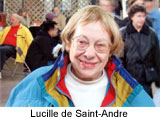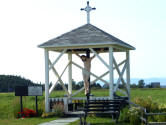|
 I always wanted to see Gaspé. For years I’d heard about the beauty
of the Gaspé Peninsula and I finally got close to it with our visit
to the Bas-Saint-Laurent region. We drove east of Quebec City,
to Kamouraska. The name means rushes along the edge of the river,
and reminders of the first people to set foot on this lovely land,
to hunt in these game-filled forests and sail on the mighty St.
Lawrence. The first settlers arrived later in 1692. The former heart
of the village, now known as Berceau de Kamouraska or Kamouraska
Cradle, was the location of the first church built in 1709, two I always wanted to see Gaspé. For years I’d heard about the beauty
of the Gaspé Peninsula and I finally got close to it with our visit
to the Bas-Saint-Laurent region. We drove east of Quebec City,
to Kamouraska. The name means rushes along the edge of the river,
and reminders of the first people to set foot on this lovely land,
to hunt in these game-filled forests and sail on the mighty St.
Lawrence. The first settlers arrived later in 1692. The former heart
of the village, now known as Berceau de Kamouraska or Kamouraska
Cradle, was the location of the first church built in 1709, two
 kilometres
of where the village is located today. A cemetery and open-air chapel
commemorate the spot. kilometres
of where the village is located today. A cemetery and open-air chapel
commemorate the spot.
Kamouraska is a delight among the region’s delightful villages.
Its breathtaking scenery extends along a stretch of the St. Lawrence,
sprinkled with islands from la Pocatière to Saint-André, and straddles
the Appalachians, reaching south as far as Maine. Numerous houses
crest the horizon upon cliffs with panoramic views. Two tourist
routes cross the region: the route des Navigateurs (132) from west
to east, and the route des Frontières (289) from north to south.
The sunsets of Kamouraska are fabulous. Its natural look outs such
as Les montage du Collège and du Père Coton offer sweeping views
of the region, from the immensity of the St. Lawrence River against
the backdrop of the massive Laurentian mountains to the north. From
l’Amphithéâtre de Saint-André one can see the sand flats, eel-fishing
weirs, and the witnesses from the age of glaciers, the monadnocks
or carbourons, isolated mountains raising up between the river and
the Appalachians.
The tide, which retreats quite far from the shoreline when low,
allows for travel to some of the islands on foot but the visitor
has to be careful to consult the tide tables so as not to be stranded
by the fast incoming water.
Some of the beautiful traditional homes are decorated in dormer
windows and arched dripstones. The village regional Museum shows
the history of the people of the region,
 colonized
in the late 17th century, and is housed in the former
convent of 1851. Located next to it is the church, l’église Saint-André
de Kamouraska. Since there is no name tag we asked six people for
its name and were told, sometimes a little impatiently, it was the
église. colonized
in the late 17th century, and is housed in the former
convent of 1851. Located next to it is the church, l’église Saint-André
de Kamouraska. Since there is no name tag we asked six people for
its name and were told, sometimes a little impatiently, it was the
église.
Named a historic monument in 2004, the church was built from 1805
to 1811, making it one of the oldest of the region of Bas-Saint-Laurent
and also of Québec, reflecting the religious architecture of New
France and certain British styles. Rural village churches are marked
by their simplicity and sobriety of style and this church is one
of the rare ones that has not been modified or aggrandized. Its
simple façade has only one door and above it two tall windows.
On the road to Saint-André de Kamouraska we came across a huge cross
at St. Germaine and later stopped to photograph
 a
cute little red-roofed house against a backdrop of afore-mentioned
mountains. Also, I noticed that the tightly lined farms came right
flush onto the road and were not set back as is mostly the case
in many countries. This makes it easier in winter to assess the
road right away. a
cute little red-roofed house against a backdrop of afore-mentioned
mountains. Also, I noticed that the tightly lined farms came right
flush onto the road and were not set back as is mostly the case
in many countries. This makes it easier in winter to assess the
road right away.
Across the church is the Niemand German bakery in a charming early
twentieth century house with a classic arch and its nice smell of
good bread and pastries. We asked for half a loaf to manage on the
road but had to settle for a whole loaf of rye and the sales lady
said they didn’t have a slicing machine. Since she’d hurt herself
wrist slicing by hand all day she invited my husband into the backroom
and gave him a big knife for self-service.
I went into the Poissonnerie Lauzier with its on-site smokehouse
which had lovely smoked fish and a delicious shrimp sandwich and
we discovered a sweet little restaurant, Amuse-Bouche, hard by the
ocean (say estuary) with fresh seafood dishes. Then we went into
Le Quai des Bulles, a soap store that had hundreds of hand-made
soap creations. The people in the stores were very friendly. We
bought home-made pâté at the charcouterie and grocery store. On
the way to Saint-André de Kamouraska we saw the birds and wildlife
on the sea and shore and the plants found on the tidal flats. We
passed Société d’écologie de la batture de Kamouraska, a huge riverside
park with picnic grounds and sports facilities on salt marshes with
a panoramic view of the islands to the north and Saint-Andre Baie.
There are 12 kilometres of trails, belvederes and lookouts.
We stayed at the Auberge La Solaillerie, managed by a charming Frenchwoman,
Thérèse Servant. It is a romantic old-fashioned Inn and is famous
for its cuisine but that night the chef was off so Thérèse kindly
gave us plates and cutlery and butter and we ate our bread and pâté
in the pretty garden, fleeing before the onset of nocturnal mosquitos.
Farm fields are right behind the garden. After dinner we took a
short walk but had to return to our room due to the pungent smell
from the fields of some high class cow manure and a mad onset of
bloodthirsty little beasts.
Breakfast in the morning was fruit, home-baked humongous croissants,
honey toast, cake with fruit, more plain toast and splendid coffee
so, after our carbo-laden meal we said goodbye to Kamouraska and
drove onward to Rivière-du-Loup.
For further information:
www.bonjourquebec.com
|
|